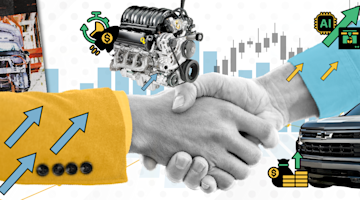You cannot chase something you don’t know exists. That’s why lead generation is the first step in any sales process. Most any marketing benchmark survey will tell you that generating business leads is the number one sales and marketing priority for most companies, and a high percentage will report challenges generating quality leads. Over the past year, these challenges have compounded with the curtailing of in-person sales meetings, trade shows, lunches with customers, networking events, open houses, and other lead-generating sources.
In its primary mission, AMT has long set the goal of supplying market access and industry intelligence to help members increase sales and decrease costs. In order to help fill the global “leads gap” for the past seven months, AMT Global Services has published a weekly “International News From the Field” article on AMTnews.org. These articles, curated by AMT’s international staff, list specific opportunities for manufacturing technology. They include known investments for new factories or expansions, government programs, incentives, policy shifts, and other market intelligence that directly affect the potential for sales. These will continue to come to you indefinitely. To peruse earlier articles, simply search “international news” on the website.
Keep in mind that according to Gardner Intelligence, in 2019, the United States accounted for about 12% of global machine tool consumption. Or, more dramatically stated, 88% of the machine tool market lies outside of the United States.
As we start a new year of strategy refinements and prospecting, we felt it might be helpful to review the submissions to date to highlight a few of the top-level regional trends.
Asia
China’s growth in new energy vehicles (NEV), particularly electric vehicles (EV), is astounding. The country’s Automotive Industry Plan states that 20% of vehicle production needs to be NEVs by 2025. That translates into 6 million NEVs a year by 2025 and represents a 40% CAGR for the next few years. The investment in EV infrastructure (charging stations, etc.) over the next five years is anticipated to be almost $900 billion! The major automotive companies are all-in with five-year investment announcements: Volkswagen and its three JV partners: $18 billion. GM’s China JV: $4.3 billion. BMW: $620 million this year alone. Toyota: $1.6 billion. You get the idea. Then there are the batteries. One of the world’s largest battery manufacturers will invest $5.9 billion to build three new battery factories.
China’s future is not all EVs, of course. Industrial robotics are booming. China has now installed almost 800,000 units. YOY growth in this sector is 21%, with 71% being imported. Almost 30% of all industrial robots in China are used in the automotive industry. Construction equipment has substantial growth as well, and a new $68 billion railway construction plan will keep that going. Also, the new Greater Bay Area (GBA) plan, which includes Hong Kong, Macau, and nine cities in the Pearl River Delta area, will require huge infrastructure investments that will trickle down to major opportunities for manufacturing technology suppliers. Of final note, the Regional Comprehensive Economic Partnership (RCEP) trade agreement was signed in November 2020. The 15 signatory countries, which includes China, represent 30% of total global population and 29% of global GDP.
India is quite bullish on EVs as well. It is estimated that the electric vehicle market in India is likely to grow to more than $7 billion by the year 2025. The new government Production Linked Incentive (PLI) scheme has earmarked $3 billion in government subsidies to foster the EV industry. In addition, the government has recently approved another $20 billion of PLI funds for ten different manufacturing sectors. The IMF projection for 2021 is that India will be the fastest growing large economy with GDP growth at almost 9%. This year should be great.
A couple of other notable programs are geared at reducing imports of manufactured products and spurring domestic production, increasing the demand for manufacturing technology. In support of the ongoing efforts to indigenize the defense industries, the Ministry of Defense announced that the FDI limit in defense manufacturing would be raised from 49% to 74%. This may be just the beginning of reforms within the defense regime to boost home-grown manufacturing. Additionally, the Department of Space (DOS) announced major reforms, allowing private companies, both domestic and foreign, to build and launch satellites using the Indian Space Research Organization’s (ISRO) knowhow, resources, and facilities. Furthermore, foreign companies could avail themselves of the program and set up their facilities in India with direct investments without requiring a partnership with a local company.
Add to all that the fact that the government plans to spend $66 billion to expand the country’s natural gas infrastructure, the state of Tamilnadu is signing $3.3 billion worth of MOUs for new projects, and they’ve created a five-year $100 billion program to develop electronics manufacturing, and you can’t avoid the fact that India has tremendous potential for sales.
Latin America
In Mexico, opportunities are expanding weekly. In the first 100 days of its implementation, the USMCA triggered $5.7 billion of investment in the Mexican manufacturing ecosystem. Four of the main automotive OEMs in Mexico announced nine-digit investments! Toyota announced an investment of $170 million to expand production of their Tacoma pickup truck in their Guanajuato plant. Ford invested $1 billion to modernize its Hermosillo plant and start producing the Bronco Sport SUV. Nissan invested $244 million to produce the eighth generation of its Sentra sedan. Volkswagen invested $600 million in its plant in Puebla for a new SUV.
The near-shoring phenomenon has also triggered heavy investment as OEMs look to Mexico as a nearby supply partner. Many companies announced big expansion plans within the automotive supply chain. San Luis Potosi has 10 new investment projects in the automotive sector to be implemented in 2021. The projects translate into $250 million of new investments. The state of Queretaro closed 2020 with 27 new projects in different industries like automotive, IT, aerospace, appliances, and food & beverage. A second phase of investments in the infrastructure with an approximate value of $10 billion was announced to be implemented between the government and the private sector.
Brazil’s Purchasing Manager’s Index (PMI) has been above 60 for the last six months. The agricultural equipment sector recorded 20% growth in 2020, and the construction equipment segment recorded growth of 22%. Once the final numbers are calculated, it is expected that Brazil will have produced 247 million tons of equipment in 2020 – a record breaker. CNH, John Deere, JCB, and Volvo all experienced significant YOY growth in sales, and it is expected to continue.
With all that equipment production, Brazil has experienced raw material supply chain issues. As a result, one local steel company opened its second blast furnace to supply the demand. This is a major development in terms of local production of iron and steel in the country.
There is also a drive in Brazil toward Industry 4.0 with major companies investing in automation and digitization – Scania ($280 million), Mercedes-Benz ($600 million), Eaton, and others are creating demand for the latest manufacturing technologies.
There are also exciting and potentially profitable developments we have reported on in other Latin American countries, most notably Colombia, Chile, Peru, and Argentina.
Europe
In Europe, look to medical, EVs, hydrogen fuel cells, and solar and wind energy. What about those electric urban air mobility vehicles and unmanned solar-powered aircraft? There’s more news, but we’re out of space here.
Whether you are a seasoned exporter or new to the game and wondering how to get started, AMT can help. We have the products, services, and expertise to assist you every step of the way to tap into that other 88%. Interested to learn more? Just give us a shout or subscribe to the AMT News e-newsletter at amtnews.org/subscribe.com.






